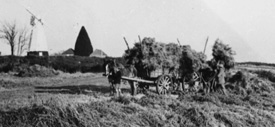Support us from £3/month
We deal with almost 1000 cases a year assisting communities, groups and individuals in protecting their local spaces and paths in all parts of England and Wales. Can you help us by joining as a member?
The Secretary of State for Environment, Food and Rural Affairs has permitted East Sussex County Council to fence the Chailey Commons at North Chailey, two miles south-west of Newick.(3) The application, to which we objected, was considered at a public inquiry in March 2010, at which the inspector was Mr Peter Millman.

Gathering bracken on Chailey Common in East Sussex in 1936. Photo: OSS collection, the Museum of English Rural Life, University of Reading
The council applied to erect fencing around three commons to the south of the A272 trunk road (Pound Common, Memorial Common and Romany Ridge Common) to form a single grazing unit, and separately around Red House Common and Lane End Common.
The council’s aim is to reintroduce grazing of the lowland heath site of special scientific interest to improve the habitat for wildlife and flora.
While we accept that it may be necessary to graze the commons, we are concerned that fencing which divides the commons into separate units will have an adverse effect on the landscape, public enjoyment and historic nature of these commons.
We are not convinced that grazing is the only way to address the problem of poor management here. We believe the council should have conducted proper pilots and experiments for alternative means of managing the commons before going ahead with a fencing scheme.
Walkers and riders have rights over all the commons. Although gates will be provided, the fences are a psychological as well as a physical barrier.
Furthermore, as the fencing is not to be entirely on the perimeter of the commons, there will be many small areas left outside the fence. These may well be lost from the common and become neglected and overgrown, or filched by adjoining landowners.
We said that we would be willing accept a pilot fencing of Lane End Common, to see the effect of grazing and whether there was an adverse impact on public access and emjoyment. Lane End is somewhat separate from the other commons, so it is a suitable site for such an experiment.
Unfortunately, the inspector rejected our helpful suggestion and the fencing is permitted for a period of 20 years, subject to Higher Level Stewardship funding being available.
